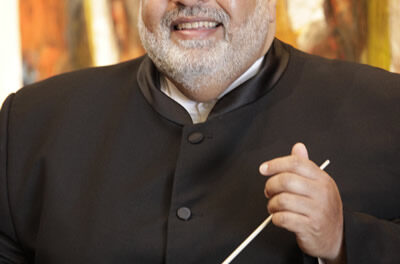As part of the North Carolina HIP Festival, the Raleigh Camerata presented a series of baroque and early classical chamber music pieces at the Church of the Nativity. In acccordance with the acronym “HIP” (Historically Informed Performances), the players used period-accurate instruments, early counterparts of modern instruments. In addition to the music itself, the concert proved to be very educational, and the artistic director of the Raleigh Camerata, Kelly Nivison Roudabush, encouraged the audience to ask questions about the different instruments during the intermission. (The artists are listed at the end of this review.)
The program began with the Vivaldi concerto “Alla Rustica,” notably short in duration but nonetheless delightful. As soon as the piece began, the room was filled with each instrument’s differing melodies. The harpsichord and baroque cello covered the bass range, while the baroque violins and viola played the primary melody. Perhaps the most unusual instrument used for this concerto was the theorbo, a large and long-necked lute that could be compared to a modern acoustic guitar.
After the joyful and waltz-like Vivaldi piece, the players switched gears to a stately quartet by Telemann. The theorbo was replaced with a baroque flute and baroque oboe. The wooden construction of the baroque flute was especially noticeable, since it created a unique timbre that sounded more airy and organic than a modern flute. This flute was also used in the following set, the cantata L’Îsle de Délos by the French composer Elisabeth-Claude Jacquet. This piece, inspired by Greek mythology, featured a soprano voice in addition to the chamber instruments. It was remarkable that, despite the tendency of voice parts to take center stage in an ensemble, the vocalist blended and interacted with the instrumentalists beautifully. In fact, the intricate melodic lines of the voice part was of course written in a style similar to the instrumentalists’ melodic lines. The soprano vocalist conveyed the pastorally descriptive text enthusiastically, matching the energy of the instrumentalists.
The second half of the program began with the use of minor keys, a definite tonal shift from the pieces that used predominantly major chords in the first half of the program. Still, only the first movement of the Fasch Sinfonia in G minor was consistently minor. The style of this sinfonia, as well as the Fasch Sonata at the end of the program, was less melodically intricate than the previous works. However, these pieces showcased impressive dynamic control and phrase shaping.
The harpsichord was featured as a solo instrument in Rameau’s Deuxième suite in E minor, showcasing the expert precision needed accurately to play contrapuntal melodies with only one instrument. The four movements of the suite each replicate the style of different French folk dances, some lively and some more regal. The concert concluded with another Fasch piece, the only piece in the program to feature the natural horn, an early horn originally made without valves. Melodically, the horn interacted with both the violin and oboe, providing harmonies or echoes.
The concert Alla Rustica: Songs of the Peasantry and Pastoral, presented by the Raleigh Camerata, was a very immersive experience. This experience was obviously appreciated by the audience, who gave a standing ovation at the conclusion of the program.
The performing artists were Margaret Carpenter, soprano, Allison Willet and Matvey Lapin, baroque violins, Joey O’Donnell, baroque viola, Brian Carter, baroque cello, Kelly Roudabush, baroque flute, Thomas Turanchik, baroque oboe, Jennifer Streeter, harpsichord, Jacob Medlin, natural horn, and Anthony Harvey, theorbo.
The HIP Festival continues through February 7. See our calendar for details.











